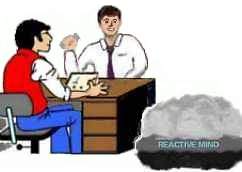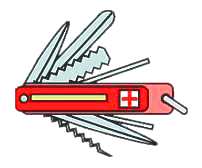|

Scales are the practical measuring sticks an
auditor uses to determine the condition of his pc. Since the purpose of
auditing is to move the pc up on these scales, the auditor that knows his
scales well will be able to keep track of his pc's progress or possibly
lack thereof.
The scales show gradients of ability or beingness.
The term "gradient scale" can be applied
to anything. It means a scale of different steps or degree of something.
It can go from zero to infinity. Depending on the direction you follow on
the scale, it could go to an infinity of wrongness or an infinity of
rightness. You could move in the direction of more and more wrong, or of
infinite right.
Absolutes, however, are considered unobtainable.
The difference between one point on a scale and the next could be wide, a
huge step - or it could be so tiny you need the utmost attention and
closest observation to see it.
Life in its highest state (top of the scales) is total understanding. Life
in its lower states is less understanding or absence thereof.
Understanding is composed of Affinity, Reality and Communication. Of the
three, communication is by far the most important. Affinity and reality,
you could say, exist to support communication.
Under the heading of affinity we have the Tone
Scale.
The Tone Scale is considered to go from +40 to -40.
Of this wide band the scale between 0.0 - 4.0 is what is directly
observable in emotion, body language and other visible signs. That is what
we concentrate on here as it relates directly to deal with other people
and pc's.
By knowing the following scale well you will be able to find an individual
on it and know a whole lot more than just his mood. It tells you the
individual's level of ARC and what behavior and reactions you can expect.
As a person goes up-scale in auditing, he goes up-scale in small steps, on
gradients of ARC.
Basic Tone Scale
Basic References: Chart of Human Evaluation from
the book: Self Analysis.
Also: Scn 0-8, Book of Basics (with Book of Scales). Science of Survival.
The basic tone scale is the most important scale to
the auditor. Each level can be determined by direct observation. Each
emotional tone has a number of characteristics visible in appearance and
behavior. If things are going well in auditing you will see: 1) the pc
moves up and down on the tone scale, 2) at the end of a process he will be
above 3.0 on the tone scale. 3) At the end of an auditing program his
chronic tone will have improved.
The same tone scale can be applied to individuals,
to businesses, to groups, to nations, etc.
An individual will have a chronic tone. That
is the tone that is characteristic for his general outlook on life.
He will have an immediate emotional tone. Good news or events will
bring him up the scale. Bad news or events will bring him down the scale.
He will have a different emotional reaction to different spheres of life.
His good friends, his interests, and his hobbies will put him in a good
mood. Detested jobs, chores, and detested people will probably put him on
a much lower level.
During a normal day, you may find the person go
through many different emotional tones, depending on whom he meets and
what he faces.
Basic Tone Scale
4.0 Enthusiasm
3.3 Strong Interest
3.0 Conservatism
2.5 Boredom
2.0 Antagonism
1.8 Pain
1.5 Anger
1.2 No Sympathy
1.1 Covert Hostility
1.0 Fear
0.9 Sympathy
0.8 Propitiation
0.5 Grief
0.375 Making Amends
0.05 Apathy
0.0 Being a Body (Death)
Here are some observable characteristics on the
most important levels:
(Taken from Chart of Attitudes in Self Analysis).

4.0 Enthusiasm
Behavior: Excellent at executing things (work,
plans). Quick reaction (relative to age group).
Speech: Capable of easily exchanging ideas and beliefs.
Reality: Can see others' reality. Searches for different
view points and a change of reality.
How literally things are taken: Can easily differentiate
facts from fiction - as jokes or lies.
Method used to handle others: Gains support by contagious
enthusiasm backed by reason.
Condition of belongings: In excellent condition. In
excellent repair.

3.3 Strong Interest
Behavior: Good at executing things (work, plans),
also sports.
Speech: Will talk about 'deep' beliefs and ideas. Will accept or
consider them.
Reality: Can understand others' reality and change viewpoint.
Agreeable.
How literally things are taken: Good grasp of statements. Good
sense of humor.
Method used to handle others: Gains support by creative reasoning
and communication.
Condition of belongings: In good condition. In good repair.

3.0 Conservatism
Behavior: Fair amount of action. Sports.
Speech: Limited number of personal ideas, tentatively presented.
Reality: Acknowledges the existence of possible other realities.
Conservative.
How literally things are taken: Can sort out the real meaning of
statements.
Method used to handle others: Gets support by practical reasoning
and built up 'connections'.
Condition of belongings: Fairly good.

2.5 Indifference, Boredom
Behavior: Somewhat inactive, but capable of action.
Speech: easy-going on pointless conversations. Listens only to
ordinary affairs.
Reality: Indifference or refusal to match conflicting realities.
Too careless to agree or disagree.
How literally things are taken: Accepts little, literally or not.
Tends to take humor literal.
Method used to handle others: Not concerned about support from
others.
Condition of belongings: Shows some signs of neglect.

2.0 Antagonism, Expressed Resentment
Behavior: Capable of destructive and some
constructive actions.
Speech: Talks in threats; invalidations. Listen to threats.
Invalidation of theta.
Reality: Verbal doubt. Disagrees. Defends own reality and
undermines others'.
How literally things are taken: Accepts threats and remarks of
tone 2.0 literally.
Method used to handle others: Nags and criticizes bluntly to get
compliance and acceptance.
Condition of belongings: Very neglected.

1.5 Anger
Behavior: Capable of destructive action.
Speech: Talks mainly of death, destruction and hate.
Reality: Disagrees with or destroys reality of others. "You
are wrong!"
How literally things are taken: Takes alarming statements
literally. Brutal sense of humor.
Method used to handle others: Uses threats, punishment and lies to
get own way and to dominate.
Condition of belongings: Often broken. In bad repair.

1.1 - 1.0 Unexpressed resentment, Fear
Behavior: Can do minor actions.
Speech: "Sweet talks" with vicious intent. Bad listener,
but likes gossip, doubletalk and lies.
Reality: Insecure. Doubts own reality. Skeptical of others'
realities.
How literally things are taken: Doesn't like to listen to
anything. Tends to take things literally, responds with doubletalk.
Method used to handle others: Seeks hidden control; blackmails and
nullifies others so they can be used.
Condition of belongings: In poor condition.

0.5 Grief to Apathy
Behavior: Can only execute relatively uncontrolled
action.
Speech: Talks little; only speaks in sad or apathetic tone.
Listens to apathy or pity.
Reality: Easily overwhelmed by others. Doubts own reality. Shame,
anxiety.
How literally things are taken: Literal acceptance of any remark
of this tone (0.5).
Method used to handle others: Cries for pity. Wild lying and
'scenes' to gain sympathy.
Condition of belongings: Usually in very bad condition.

0.1 Deepest Apathy
Behavior: Alive as a body, but almost no action.
Speech: Does not talk. Does not listen.
Reality: No reality. Complete withdrawal from others' reality.
How literally things are taken: Accepts anything literally.
Method used to handle others: Pretends death to avoid others and
dangers.
Condition of belongings: Does not care for belongings or realize
ownership.
We are here using and covering the tones
listed on Chart of Attitudes. See Self Analysis.
The Basic Tone Scale above is the directly
observable scale on your pc or any human being.
Uses of the Tone Scale
How to do a " two-minutes psycho-metric
test"
In a normal conversation you drop great news and
see how your partner reacts.
("Did you hear that our team won last night?")
You talk about a cause most people are against (feel antagonistic about).
("The new taxes are terrible.")
You talk about something Scary (Fear).
("Did you read about the murder?")
You talk about something sad or dreadful (Grief, Apathy).
("Did you hear that the council man died?")
You can of course use tones in between and explore each tone with a number
of subjects.
You notice the partner's response to each. Where
his/hers reaction is most significant, that is where he is on the scale.
Raising Somebody's Tone
This is a very effective tool in daily life. It
ought to be called an auditing process. On the other hand it ought not to,
because it is in the very fabric of human relationships. If you learn how
to use it smoothly it will help you understand and handle all kinds of
impossible situations. By drilling it knowingly in your daily life you
will see your willingness to talk to and deal with all kinds of people
improve happily. You can drill it on your own, simply as a part of talking
with all the people you meet in your daily life. You will see angry
people, impossible to get through to, suddenly crack up and laugh if you
use antagonism (you don't have to attack who you are talking to - you can
attack the government if that is appropriate).
Example: Let's say you find your friend,
Sue, at the tone of grief (0.5) on the scale. Sue's dog, Fido, has run
away. You can raise her tone by 'matching tone'. You stay on a tone level
0.5-1.0 higher on the scale. That would be Sympathy (0.8) and Fear (1.0)
up to Anger (1.5). You could express sympathy for her troubles, "Oh,
that is terrible. You must feel awfully worried, Sue. It almost makes me
cry too."
Then you can smoothly express fear about it, "I hope Fido keeps
out of traffic..." This will get the person's attention. It is
already starting to wake her up. You wouldn't stop there, of course. Then
you could express anger towards something relevant, "Those drivers
drive like maniacs around here. The other day....". This is the way
you get the person's attention and raise her from the original grief. She
may be worried, upset, or angry about what you just said. But that is
progress - going up the scale. So you have to keep up the process until
the person is more cheerful, more ready to act. At some point: "Maybe
we should go and look to see if he ran into the park on his own."
Looking for Fido would at least be at 3.3, interest. She may not fully
have made it up the scale yet, but doing something about it helps. The
situation will usually give you the script and the things to address as a
logical thing.
Trying just to be 'enthusiastic' about things to
cheer her up wouldn't work at all, such as, "I am sure Fido is OK,
why don't we go and see this great new movie..." It is too much of a
jump for the person to consider and does not fit the situation in the
example either. Doing the Raising Tone Routine is the ARC triangle at
work. Tone=A. Subject matter=R. Conversation=C.
Emotions are
three things:
1) Engramic
response to situations (such as irrational fears, outbursts of anger -
like bad temper, etc.)
2) Endocrine metering of the body to meet situations on an analytical
level. To get the adrenalin pumping is an endocrine phenomenon. The
glands pump the adrenalin into the blood stream to make the body alert and
ready to fight. Fear is a quick withdrawal from danger and can of course
be quite rational. The body is also given endocrine or biochemical
commands to bring that about.
3) The inhibition or the furtherance of life force. The higher on the tone
scale the more life force or theta is present.
From: "Modern Science of Mental
Health".
|



















